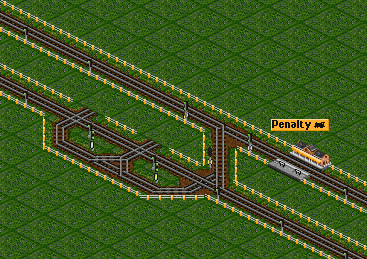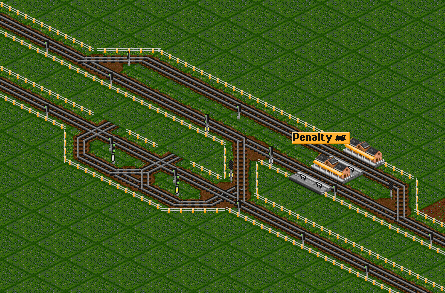Difference between revisions of "Unbalancers"
From #openttdcoop wiki
(→Unbalancer with Bypass) |
m (marked as update) |
||
| (One intermediate revision by one other user not shown) | |||
| Line 1: | Line 1: | ||
| + | {{update}} | ||
| + | |||
'''NOTE: This page is not final yet, so it might look messy and contain incorrect information.''' | '''NOTE: This page is not final yet, so it might look messy and contain incorrect information.''' | ||
==<center>Unbalancer</center>== | ==<center>Unbalancer</center>== | ||
| Line 11: | Line 13: | ||
==Unbalancer with Bypass== | ==Unbalancer with Bypass== | ||
If a switching train is jammed and is blocking the upper track, a bypass is made. The bypass ensures the continuous flows of trains on the upper track. The bypass also needs a penalty station, else trains will use the bypass and not switch to the lower track. | If a switching train is jammed and is blocking the upper track, a bypass is made. The bypass ensures the continuous flows of trains on the upper track. The bypass also needs a penalty station, else trains will use the bypass and not switch to the lower track. | ||
| − | [[Image:Unbalancer_with_bypass.png| | + | [[Image:Unbalancer_with_bypass.png|445px|thumb|center|If a train stops in the branch, other trains can pass by using the bypass]] |
Latest revision as of 08:49, 4 December 2013
| This article may need to be updated. Please update this article to reflect recent events or newly available information, and remove this template when finished. Please see the talk page for more information. |
NOTE: This page is not final yet, so it might look messy and contain incorrect information.
Unbalancer
Overview
The Idea behind unbalancers is, that you want to keep the traffic on 1 lane while the second lane is as empty as possible. The principle is called SML.
Simple Unbalancer
To move trains onto one single lane, a track between them is made. To prevent trains switching tracks while a train is close to the switch, priority is added. To force the switching, a penalty is added to the track that has to be empty.
Unbalancer with Bypass
If a switching train is jammed and is blocking the upper track, a bypass is made. The bypass ensures the continuous flows of trains on the upper track. The bypass also needs a penalty station, else trains will use the bypass and not switch to the lower track.

